|
|
|
Sort Order |
|
|
|
Items / Page
|
|
|
|
|
|
|
| Srl | Item |
| 1 |
ID:
112657
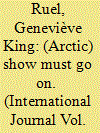

|
|
|
| 2 |
ID:
074552
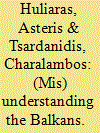

|
|
|
|
|
| Publication |
2006.
|
| Summary/Abstract |
For most Greeks, neighbouring countries like Yugoslavia, Bulgaria, Romania and Albania formed a terra incognita for almost half a century since the end of the Second World War. In the early 1990s communism collapsed in all four countries and despite the three bloody wars that followed the break-up of Yugoslavia, information, goods and people crossed Balkan boundaries in unprecedented speed. The paper examines three geopolitical codes about the Balkans that successively dominated Greek views and policies in the last fifteen years: the idea of a menacing 'muslim arc', the image of the Balkans as a Greek 'natural hinterland' and the idea of the Balkans as an undisputed part of Europe. All these geopolitical ideas were introduced by the Greek political elite and influenced decisively both Greek foreign policy and public attitudes for about half a decade each.
|
|
|
|
|
|
|
|
|
|
|
|
|
|
|
|
| 3 |
ID:
155468
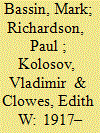

|
|
|
|
|
| Summary/Abstract |
The essays collected in this forum discuss the geopolitical legacy of the Russian Revolution of 1917, one of the most momentous political events of the twentieth century. From a range of different academic disciplines and perspectives, the authors consider how the profound transformations in society and politics were refracted through space and geography, and how enduring these refractions proved to be. The authors focus on three themes that have been dominant in Russian affairs over the past century: 1)the problem of center-periphery relations, 2)the civilizational dynamics of Russia’s self-identification in relation to Europe and to Asia, and 3)the geopolitics of national identity.
|
|
|
|
|
|
|
|
|
|
|
|
|
|
|
|
| 4 |
ID:
125600
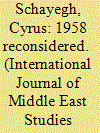

|
|
|
|
|
| Publication |
2013.
|
| Summary/Abstract |
Using Arabic, English, and French sources, and engaging Middle East and Cold War historians, this article makes a threefold argument. First, in United Arab Republic (UAR)-Syria, Jordan, and Lebanon, the 1958-59 explosion of domestic and regional tensions triggered state-formation surges. Second, these formed one process, which made those states more alike, with state-led socioeconomic planning playing a key role. Third, that process partook of a global Third World trend intersecting with the early Cold War. I draw three conclusions. Although existing scholarly readings that the events of 1958-59 in the Arab Middle East formed a crisis but not an ideological or political watershed are correct, from the viewpoint of state formation this crisis was a milestone. Moreover, UAR-Syria, Jordan, and Lebanon had persisting affinities and shared regional positions-notably, the fact that all were sandwiched between the unstable poles of the Arab state system, Iraq and Egypt-that shaped their individual postindependence histories of state formation. Last, Washington's low-profile involvement in this state-formation surge illustrates how domestic sociopolitics and regional geopolitics-including the UAR's peaking popularity and influence in 1958-59-affected U.S. policy in the Cold War postcolonial world.
|
|
|
|
|
|
|
|
|
|
|
|
|
|
|
|
| 5 |
ID:
132807
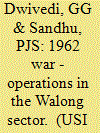

|
|
|
|
|
| Publication |
2014.
|
| Summary/Abstract |
While the Chinese main offensive in the Eastern Theatre was directed against the Tawang - Bomdi La Sector, the subsidiary was launched in the Walong Sector. The Chinese aim was to annihilate the Indian troops deployed in Walong Sector and in the process advance upto their claim line of 07 Nov 1959, i.e. almost the foothills. Initially on the Indian side, Walong Sector was the responsibility of 5 Infantry Brigade which was part of 4 Infantry Division. It was the Assam Rifles which manned the border posts. In response to occasional Chinese incursions through the Lohit Valley, 2 RAJPUT was moved into the area. In Mar 1962, it was replaced by 6 KUMAON.'
|
|
|
|
|
|
|
|
|
|
|
|
|
|
|
|
| 6 |
ID:
111690
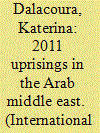

|
|
|
|
|
| Publication |
2012.
|
| Summary/Abstract |
The Arab uprisings of 2011 are still unfolding, but we can already discern patterns of their effects on the Middle East region. This article offers a brief chronology of events, highlighting their inter-connections but also their very diverse origins, trajectories and outcomes. It discusses the economic and political grievances at the root of the uprisings and assesses the degree to which widespread popular mobilization can be attributed to pre-existing political, labour and civil society activism, and social media. It argues that the uprisings' success in overthrowing incumbent regimes depended on the latter's responses and relationships with the army and security services. The rebellions' inclusiveness or lack thereof was also a crucial factor. The article discusses the prospects of democracy in the Arab world following the 2011 events and finds that they are very mixed: while Tunisia, at one end, is on track to achieve positive political reform, Syria, Yemen and Libya are experiencing profound internal division and conflict. In Bahrain the uprising was repressed. In Egypt, which epitomizes many regional trends, change will be limited but, for that reason, possibly more long-lasting. Islamist movements did not lead the uprisings but will benefit from them politically even though, in the long run, political participation may lead to their decline. Finally, the article sketches the varied and ongoing geopolitical implications of the uprisings for Turkish, Iranian and Israeli interests and policies. It assesses Barack Obama's response to the 2011 events and suggests that, despite their profound significance for the politics of the region, they may not alter the main contours of US foreign policy in the Middle East in a major way.
|
|
|
|
|
|
|
|
|
|
|
|
|
|
|
|
| 7 |
ID:
129894
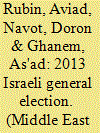

|
|
|
|
|
| Publication |
2014.
|
| Summary/Abstract |
Despite resulting in a different party configuration, the results of the 2013 Israeli general election support a similar agenda to the one set by the previous government. A year following its establishment, all indicators suggest that the current government continues to deepen neoliberal policies. Nevertheless, this election reflects two important trends: first, an ever growing discontent in Israeli public that probably would not find a solution during the tenure of the incoming government; second, lack of interest in the Israeli-Palestinian conflict that might generate negative long-term consequences.
|
|
|
|
|
|
|
|
|
|
|
|
|
|
|
|
| 8 |
ID:
180415


|
|
|
|
|
| Summary/Abstract |
When we think of a technological race to achieve geopolitical hegemony (some might even say technological Cold War), most of the times two concepts appear in our mind: artificial intelligence and 5G. Warnings about the perils of the use of artificial intelligence have not stopped governments or even private corporations such as Google from pursuing supremacy in the field. The case of 5G is even more notorious. The anxiety of Western countries to find a local champion to dispute China's Huawei leadership is well known. Those are not the only disruptive technologies that are powerful assets in the chessboard of geopolitics. Industrial 3D printing could join them in a not distant future.
|
|
|
|
|
|
|
|
|
|
|
|
|
|
|
|
| 9 |
ID:
139074
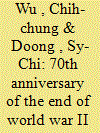

|
|
|
|
|
| Summary/Abstract |
In the closing stages of the Second World War, the world was divided into the capitalist side led by the United States and the communist side commanded by the USSR. A new bipolar structure called the “Cold War” was gradually established in the second part of the twentieth century. Basically this “cold” war structure was maintained between the two superpowers in the major areas of the world like Europe, but neither in the Korean peninsula nor in Vietnam, nor in Taiwan Strait since several “hot” wars took place in these regions.1 During that period, South
Korea, South Vietnam and Taiwan all had the support of the United States to resist the military threat of the other side supported by the communist USSR and China. Later, the capitalist South Vietnam was unable to resist the invasion of the North and collapsed. On the other hand, South Korea succeeded in developing the strength of the country and became a major middle power in the world. For strategic reasons, Taiwan lost formal political recognition of the world to the
profit of Communist China, but continues to flourish until now. The two Vietnams and the two Koreas all have similar sizes in term of territory and population. By contrast, China is 268 times larger than Taiwan calculated by territorial size, 60 times bigger by population power, and is actually the second largest global economic power after the United States. Without diplomatic allies, besides some smaller states, Taiwan still continues to prosper with its special security strategy. Seventy years after the end of the Second World War, this article aims to provide an understanding of the geopolitical strategy of Taiwan that continues to guarantee its future.
|
|
|
|
|
|
|
|
|
|
|
|
|
|
|
|
| 10 |
ID:
130619
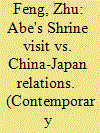

|
|
|
| 11 |
ID:
139172
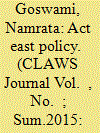

|
|
|
|
|
| Summary/Abstract |
For many years now, since 1992, when it laid its seed and slowly gathered momentum in policy circles, the “Look East” policy has been oft repeated in New Delhi’s strategic and policy circles as one of India’s foremost long-term policy visions to open up its economy for investment and trade with Southeast Asia. Increasingly now, the reference has changed from “Looking East” to “Acting East” by which one would expect that the policy is in its implementation phase. In augmenting the “Act East” policy, the northeast of India emerges, by the criterion of geography, as the region which will act as the ‘strategic catalyst’ or ‘game changer’ in accomplishing the vision that the policy aspires to embolden. Situated between China, Bhutan, Bangladesh, and Myanmar and with an international border stretching up to 4, 500 km, the region has held the promise of acting as a bridge between India and Southeast Asia for years. Its history vindicates such a role as its people have traded and travelled across the Southeast Asian region and Yunnan for years through the ancient Silk Road, trading in Himalayan salt, spices, handicrafts, food items, silk and other goods. This region witnessed migration of people from Southeast Asia and Yunnan to Assam and its surrounding hills, the most prominent being the Ahoms tracing their roots to the Tai race in Yunnan and Thailand. The Ahoms led by Sukapha arrived in Assam in
1228 A.D. and ruled over this region for 600 years. It is significant to note that the Ahoms under Lachit Borphukan successfully prevented Mughal expansion into Assam by defeating the Mughal Army in the much revered Battle of Saraighat of 1671.1
|
|
|
|
|
|
|
|
|
|
|
|
|
|
|
|
| 12 |
ID:
107142


|
|
|
| 13 |
ID:
107559
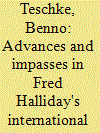

|
|
|
|
|
| Publication |
2011.
|
| Summary/Abstract |
How did Fred Halliday recast International Relations (IR) theory as international historical sociology? This article explores Halliday's intellectual trajectory across this terrain and suggests that the notion of 'capitalist modernity', derived from an amalgamation of neo-Marxian and neo-Weberian historical sociology, functioned as the strategic master-category, which anchored his thought on International Relations throughout his work. This category was successively reconceived and complemented to generate four, partly contradictory, analytical frameworks at a lower level of abstraction: 'global conjunctural analysis'; a neo-Weberian 'sociology of the inter-state system'; 'international society as homogeneity' and 'uneven and combined development'. The article identifies the advances and impasses in each intellectual move and exemplifies the limits of Halliday's approach in relation to his analysis of revolutions. It suggests that while Halliday was instrumental in reconnecting IR with historical sociology, providing crucial openings and correctives to mainstream IR theory, his theoretical emphases remained ultimately too syncretistic and additive to shift the debate on firmer ground. While this can be read as a failure, there is also evidence to understand this anti-formalism as a deliberate intellectual choice. The article concludes by suggesting that the very term international historical sociology, predicated on a distinct modernist vocabulary, may itself preclude a full historicization of categories of analysis, restricting its use as a general framework for capturing the historicity and sociality of geopolitical practices across time and space.
|
|
|
|
|
|
|
|
|
|
|
|
|
|
|
|
| 14 |
ID:
094508
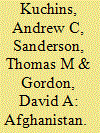

|
|
|
| 15 |
ID:
152172
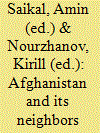

|
|
|
|
|
| Publication |
Lanham, Lexington Books, 2016.
|
| Description |
xiv, 225p.hbk
|
| Series |
Contemporary Centra Asia: societies, politics and cultures
|
| Standard Number |
9781498529129
|
|
|
|
|
|
|
|
|
|
|
|
Copies: C:1/I:0,R:0,Q:0
Circulation
| Accession# | Call# | Current Location | Status | Policy | Location |
| 058989 | 355.0330581/SAI 058989 | Main | On Shelf | General | |
|
|
|
|
| 16 |
ID:
130865
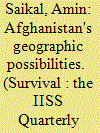

|
|
|
|
|
| Publication |
2014.
|
| Summary/Abstract |
Afghanistan's geostrategic potential is hampered by domestic weakness, regional tensions and major-power competition. Historically, Afghanistan's position at the junction between Asia and Europe has not only made it susceptible to outside invasions and influence, but also rendered it an important conduit for cross-continental interactions. The Greco-Bactrian (250-150 BCE), Kushan (30-375 AD) and Sassanid (224-651 AD) empires derived much of their wealth from the Silk Road, a series of interlinked trading networks criss-crossing the Eurasian land mass and centred around what is now known as Afghanistan. These routes served as the main arteries of east-west trade and transportation, until the disintegration of the Mongol Empire in 1368 AD effectively dismantled the network.
|
|
|
|
|
|
|
|
|
|
|
|
|
|
|
|
| 17 |
ID:
131852
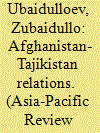

|
|
|
|
|
| Publication |
2014.
|
| Summary/Abstract |
This article attempts to touch upon the relations between Afghanistan and Tajikistan, two neighboring countries, from the historical perspective and the current period. The article analyses the history of Afghanistan-Tajikistan relations during and after the Soviet era, especially during the Afghan Mujahideen's struggle against the Soviet occupational army and Taliban regime in Afghanistan, the Tajikistan civil war of 1992-1997, and after September 11, 2001. In addition, the issues of the ethnic Tajiks in Afghanistan, the violent and vulnerable Tajik-Afghan border, the withdrawal of NATO troops from Afghanistan in 2014 and its impact on Afghanistan-Tajikistan relations, and the new phase of economic relations and an effective cooperation between the both countries are discussed. The article tries to fill the gaps within the body of existing literature and understanding concerning the topic.
|
|
|
|
|
|
|
|
|
|
|
|
|
|
|
|
| 18 |
ID:
113595


|
|
|
| 19 |
ID:
176927
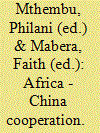

|
|
|
|
|
| Publication |
Switzerland, Palgrave Macmillan, 2021.
|
| Description |
xi, 240p.hbk
|
| Standard Number |
9783030530396
|
|
|
|
|
|
|
|
|
|
|
|
Copies: C:1/I:0,R:0,Q:0
Circulation
| Accession# | Call# | Current Location | Status | Policy | Location |
| 059979 | 337.6051/MTH 059979 | Main | On Shelf | General | |
|
|
|
|
| 20 |
ID:
082707


|
|
|
|
|
| Publication |
2008.
|
| Summary/Abstract |
The paper examines the Dutch humanitarian response to the 2004 Indian Ocean earthquake through the lens of geopolitics. It analyses the ways geopolitical representations shape non-state collective action, in this case the relief effort to help victims of the tsunami of 26 December 2004. Drawing on earlier work on geopolitical visions and national identity, the paper develops a framework to study people's geopolitics, the geopolitics of non-state collective actions. These insights are further explored through an examination of the Dutch tsunami relief effort. The paper discusses how the Dutch media framed this collective action as a national effort and articulated a sense of proximity and responsibility to mobilise people's generosity. Dutch geopolitical vision and national identity (water as a major threat to the national territory, the country's role as development aid donor, its relation to the regions affected) offer a frame to mobilise people. The tsunami is also analysed as a critical event for Dutch geopolitical representations and the tsunami relief effort as a peak experience providing a sense of recovered national identity in times when Dutch society was painfully divided between Muslims and non-Muslims after the murder of Theo van Gogh in November 2004. The concluding section discusses directions for further research into people's geopolitics.
|
|
|
|
|
|
|
|
|
|
|
|
|
|
|
|
|
|
|
|
|